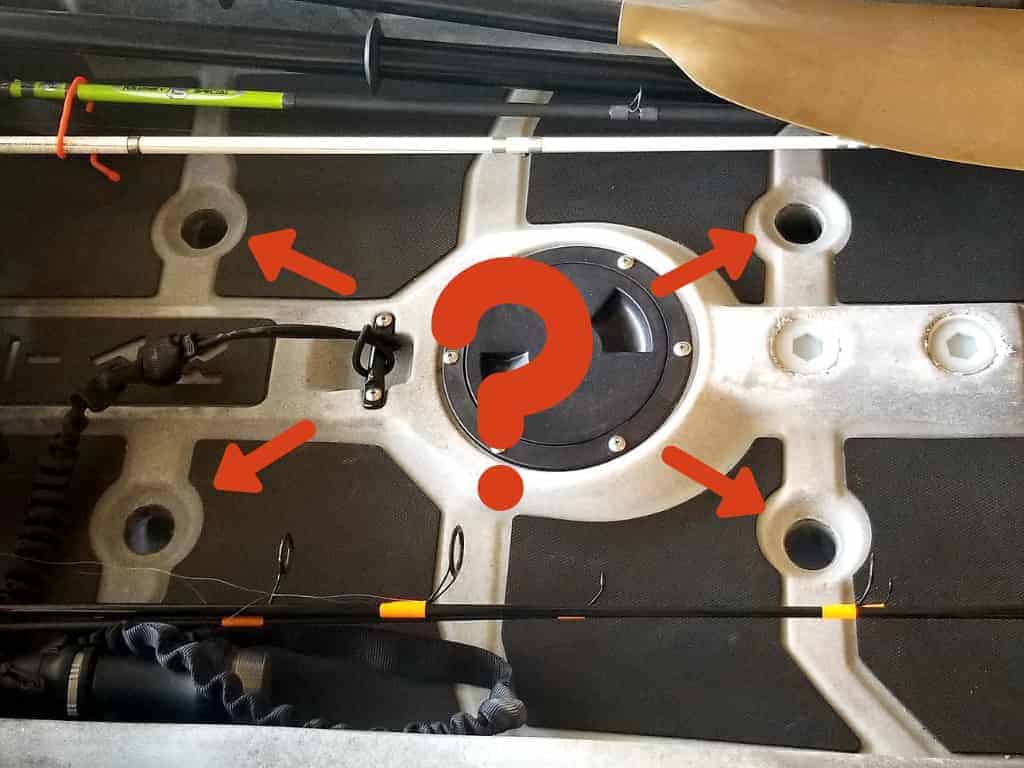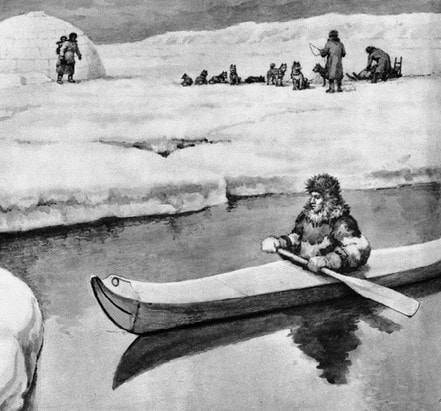You would think having four or more holes in the bottom of your kayak would be bad! But those holes are there for a reason! Folks new to kayaking often ask, “Why do you need these holes in your kayak?”
The holes in your kayak are called scuppers. Scuppers are molded into the kayak and allow water that has splashed into it to drain back out. The standard number of scuppers is four, but there can be ten or more scuppers in a kayak. Scuppers are commonly found near the seat and storage wells.
When you start fishing from a kayak, there are always questions and new things to learn. And the holes you see in the bottom of the kayak are what intrigues people quite a bit of the time!
So, let’s begin with the history of the scupper!
What are Scupper Holes?
Scupper holes are commonly found inside of sit-on-top kayaks from all the major manufacturers. You’ll find these holes from the most expensive fishing kayaks to the least expensive. Yes, scuppers are that important!

Even though modern-day kayaks have scupper holes, the scupper itself isn’t anything new! They go far back into history and were used by many seafaring adventurers, especially the Inuits.
Inuits developed and began using kayaks to hunt and fish near the ice flows, inland waters, and coastal regions centuries ago! So even today, many of us somewhat follow their traditions!
And since the kayaks of their day sat so low in the water, it was common for waves to break over them and swamp their kayak while out on the ocean. This wasn’t a good thing!
The Inuits eventually designed spray skirts made of seal skins to prevent water from entering the kayak, and they were able to hunt and fish from their kayaks far safer than before!

Many sit-in kayaks have scupper holes at the rear so that water can be drained from the kayak once it is pulled out of the water and onto dry land.
As kayaking and fishing from kayaks became more popular, sit-on-top kayaks were designed and sold to the public. The SOT is basically a floating platform with a seat.
Scupper holes are small golf ball-sized holes in the kayak’s floor decking that allow any water that comes into the kayak to flow back into the water.
For most fishing kayaks on the water today, the standard size of a scupper is 1.25″, which is 3.175 cm if you’re a metric user.
Do I Need to Plug the Holes in My Kayak?
So, what should you do with these holes in your kayak, and when should you do it?
In rough waters and when water splashes in your kayak, leave the scuppers unplugged so that water can exit. Otherwise, your kayak can fill with water, become harder to paddle, and may swamp. In calm waters, you can plug your scuppers so you don’t become wet. Proper scupper plugs are easy to place and remove.
There are a wide variety of scupper plugs for different applications you can view at Amazon!
Some folks always plug their scupper holes, while others prefer to leave them open. In my opinion, you should be able to kayak with them open or closed whenever the conditions warrant it!
Wherever the water line is located on your kayak, the water level will be the same inside the scupper hole.
If you’re heavier or carrying more gear than normal, the water line can rise within the scupper or even enter the bottom of your kayak!
If so, you would want to plug your scuppers to keep water from entering through the bottom or kayak with a craft rated for your weight and load capacity.
For more information on weight and load capacity take a look at my article Kayak Weight Limits Explained for Larger Anglers
Sit-on-top kayaks generally have well-raised seats with scupper holes beneath them. Any water coming in should drain out if you have a kayak rated for your weight and load capacity.
This will keep you from sitting in a puddle of water while fishing!
Scupper Holes in Rough Waters
When kayaking in choppy waters or paddling through breakers to reach good fishing holes, you will most likely want to leave the scuppers open.
By having them open, you allow any water that breaks over your kayak to flow back down through the holes and out of the kayak!
If you decide to leave the scuppers open in these conditions, be prepared to take on water. A SOT won’t necessarily sink, but it can become heavier with the water’s additional weight and more difficult to paddle.
Also, with them open, you’ll most likely end up with water splashing around your seat and sitting in a wet spot all day. If it’s a nice day out, I don’t mind being wet now and then, but I don’t like being wet all day when it’s not as nice either!
Scupper Holes in Calm Waters
In calmer waters, and again it’s my personal preference, I enjoy fishing with the scuppers plugged!
Here’s the thing with scuppers and sit-on-top kayaks: water can come in from either the top or the bottom! With my weight and gear, the hull may push into the water more than with you, and water rises through the scuppers.
By having my scupper holes plugged, less water enters my kayak from below, and since the water is calm, very little comes over the side—just what may drip off my paddle from time to time.
What Are Scupper Plugs?
Scupper plugs are placed into the holes in the bottom of your kayak, keeping water from leaking onto the deck.
Several different types of scupper plugs can be purchased online or in most sporting and outdoor stores, and kayakers even make their own from practice foam golf balls!
Do I Leave the Plugs In All the Time?
Many kayakers will leave scupper plugs in all the time. Others will carry them along since they take up little room and plug the scupper holes when needed.
If you’re in calm waters and don’t want any water coming up through the holes, by all means, insert plugs into the holes!
If you’re in rougher or choppy waters and need to get your kayak out through the surf, you’ll definitely want to have the scupper plugs pulled. With the scupper holes open, any water breaking over your kayak will exit through the holes!
What if Water Gets Into My Kayak?
Sometimes I have fishing gear and tackle boxes lying on the floor of my kayak, and I hate getting water inside of my storage boxes! Hooks get wet and begin to rust, etc.
Related article: Dealing With A Sinking Fishing Kayak
Here are two options to bail the water out of your kayak if need be!
Kayak Sponge
My preferred method of getting water out of my kayak is with a sponge!
You can soak up water and squeeze it out over the side fairly quickly as needed. A regular large-sized kitchen sponge will work, and I have a few of them floating around in my truck just for this purpose.
My favorite sponge is the Perception Kayak Sponge on Amazon. It has a lanyard to keep it handy, easily squeezes to a small size to store away, and will hold a liter of water!
A regular sponge doesn’t hold as much water; when it is dry, it’s as hard as a rock! Plus, I’ve lost them in the water when they get knocked out of the kayak!
Kayak Bilge Hand Pump
If you’re in a sit-inside kayak or have more water than normal getting into it, a hand bilge pump may be what you’ll need.
The bilge pump is more cumbersome to carry with you than a sponge, but it does move the water out of your kayak when needed!
The Perception Bilge Pump on Amazon does a great job, and the one I’d carry if the sponge weren’t enough. It will pump out a gallon of water in about 12-14 pump strokes and won’t corrode in saltwater.
So there you have it! This is why there are holes in the bottom of your kayak what to do if you get a little water into your kayak and two of the more common ways to get the water out!
Have fun, and stay safe out there!
